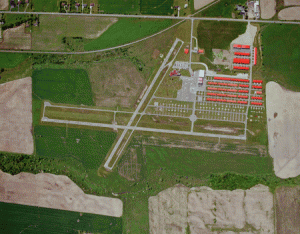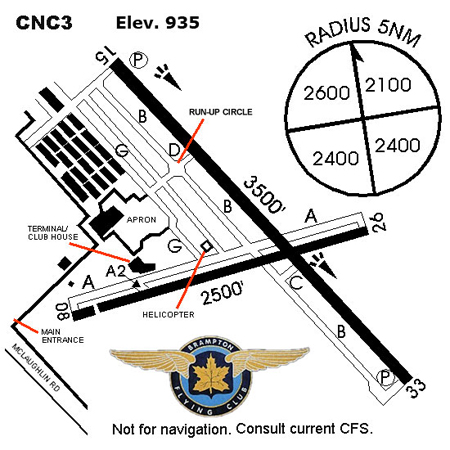Airport Information

The Brampton-Caledon Airport (CNC3) is owned and operated by the Brampton Flying Club. It is situated on 240 acres in the Town of Caledon. The airport is just 8 miles north of the City of Brampton and 12 miles northwest of the Toronto Lester B. Pearson International Airport (CYYZ). The address of the Brampton-Caledon Airport is 13691 McLaughlin Road, PO Box 27, Stn. Cheltenham, Caledon, Ontario, L7C 3L7.
Coordinates: N43° 45′ 35″ W79° 52′ 26″
Elevation: 936′ ASL
Circuit Height: 1900′ ASL
Rwy 15/33: 3500′ long x 40′ wide, paved, lighted
Rwy 08/26: 2500′ long x 40′ wide, paved, lighted
The airport and airspace are uncontrolled and communication is broadcast to “Brampton traffic” on 123.3 MHz. Unicom is available for advisories.
The airport is served by a VOR/DME instrument approach off of the Toronto (YYZ) VOR and an RNAV approach to runway 15. Arriving by air, the airport is located 12nm from the Toronto (YYZ) VOR on the 310 radial at N43° 45′ 37″ W79° 52′ 30″.
The airport is below Class C airspace, which has a base of 2500′. When arriving from or departing to the south, you must contact Toronto Terminal (119.3) for clearance. Consult the VNC and CFS for airspace restrictions and all airport information.
Nav Canada VFR Initiatives
Currently, many aircraft that transit the Toronto area do so just outside or below the Class C airspace. This results in opposite direction VFR traffic conflictions. To address this risk, charted one-way VFR routes are published in the Toronto VFR terminal area chart (VTA).
There are three routes to the north of Toronto. The routes are named by the last checkpoint they pass, so all communications that pilots will hear tell pilots where the aircraft is going, not where it has been. These routes can be used by VFR pilots below Class C airspace or, with a clearance from ATC, they may be transited within the terminal airspace structure. In addition, heavily used VFR routes into and out of Brampton and Buttonville airports, which cross the northern transit routes, are depicted on the Toronto VTA and appropriate VFR terminal procedures charts (VTPCs) with their related caution text boxes.
Centred on the back of the new VTA is a planning map. While not for navigation, it includes the new VFR transit routes and instructions for their use. The CFAs are depicted, including examples of proper phraseology.
CNC3 Services:
100LL fuel, Transport Canada approved AMO and Cessna Parts Centre, helicopter pad, customs for CANPASS participants, transient hangarage, flight catering, well suited to fixed wing and helicopter Medevac/Ambulance transfers, after hours service by prior arrangement only, camping on airport grounds with prior authorization, washrooms.
More Information on the Brampton-Caledon Airport
The Brampton‐Caledon Airport is approved by Transport Canada as a Certified Airport. The airport is owned by the Brampton Flying Club and has operated at this location in Caledon since 1969. It was listed as the 16th busiest airport in Canada in an Economic Impact Study prepared by Jocelyn Purcell, Executive Director of Inside Canadian Airports in 2009.
The Brampton‐Caledon Airport is normally operational 24 hours per day, 7 days a week; and is capable of supporting both visual flight rules (VFR) and instrument Flight Rules (IFR) operations to non‐instrument approach limits; and IFR departures in visibility down to ½ statute mile.
The critical aircraft for the airport is the King Air and Citation Jet.
The movement area consists of two runways and a joining taxiway system, and a public fixed wing apron and helicopter apron. The primary runway 15‐33 is currently 3500 ft long by 75 ft wide with 40 ft centre asphalt surface. Runway 15‐33 is approved by Transport Canada as a 2A Non‐instrument runway and has magnetic bearings of 146 degrees and 326 degrees. The secondary runway 08‐26 is 2500 ft by 75 ft with a 40 ft centre asphalt surface. See Appendix B for Aerodrome Chart and Airport Approaches.
The Brampton‐Caledon Airport is a busy general aviation (GA) facility. The traffic is made up of mostly light piston aircraft along with some activity with turboprop aircraft and helicopters. The airport is home to one of the largest flight schools in Canada and the majority of movements are related to student training flights and rental of aircraft.
There are approximately 110,000 movements flown in a year.
The airport is critical to the future of general aviation in the Toronto GTA, particularly with the future closing of Buttonville Airport. The activities at the Brampton‐Caledon Airport offer many economic and social benefits to the community. There is a strong correlation between the total jobs sustained by airport activities and the relative wealth of the community served by an airport. Although Brampton does not have scheduled service, the airport draws thousands of visitors to the area annually.
The 2006 Economic Impact Study calculated 105.4 full time jobs and approximately $11.7 million is generated by the activities of the airport for the provincial economy on an annual basis. Approximately 70 people are currently employed at the airport.
Thousands of pilots have trained at the Brampton‐Caledon Airport, education providing career and job opportunities. The Brampton Flight College Program, approved by the Ministry of Colleges and Universities, has been running for 15 years.
The 892 Snowy Owl Air Cadet Squadron located at the airport provides many opportunities for young people.
The Great War Flying Museum is the only one of its kind in Canada and provides education to people from around the world about aviation history in Canada and World War 1.
The airport is home to the Toronto‐Recreational Aircraft Association; volunteers dedicated to the promotion of flying as a hobby for ordinary Canadians.
The airport is also a transportation base connecting the community and businesses access to the National Air Transportation Network.
Medevac flights are facilitated giving the community access to emergency health care services.
The airport is a destination and focal point within the community for recreational and volunteer opportunities including youth camps and a meeting place for seniors, scouts, and schools. The airport is also a tourist destination which stimulates the local economy. Airport events raise substantial funds for local community charities.
There are approximately 145 privately owned hangars at the Brampton‐Caledon Airport and 250 aircraft based here.
Services include flight training, aircraft maintenance and fueling services, a terminal building/clubhouse, and restaurant.
The airport has an approved Safety Management System in place to ensure Certified Airport safety regulations, standards and guidelines are met.
The Brampton‐Caledon Airport and a major new 400 series highway are potentially good and compatible neighbours.
For more information, please contact the General Manager, Allan Paige, at 905‐838‐1400 Ext. 222 or email [email protected].


